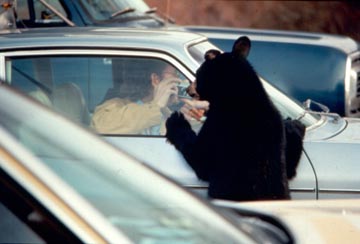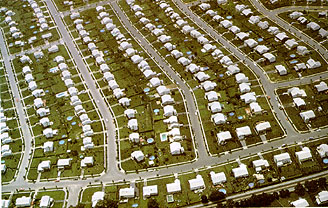(Based on Paul Sutter, Driven Wild:
How the Fight Against Automobiles Launched the Modern Wilderness
Movement,
and Adam Rome, The Bulldozer in the Countryside)
and Adam Rome, The Bulldozer in the Countryside)
Are nature and technology opposites?
- we fall into seeing them that way, but they aren't
- what I want to argue today is that our current ideas about nature are a result of the automobile
- in colonial times most
people saw wilderness as dark, dangerous, and horrible. Generally
resources were seen as inexhaustible, though there was occasional
concern about preserving resources (particularly forest) near towns
- in Europe the environmental
movement has always concentrated on preserving farmland and managed
forests--nature carefully managed by human beings--there isn't any
untouched wilderness
Cars lined up to enter
Yellowstone in 1916


The
automobile made it possible for people to explore American scenery
- Yosemite was preserved for public
use by a federal law in 1864 but initially turned over to the state of
California to administer, Yellowstone
was established in 1872 as the first national park, the National Park
Service was created until 1916
- National Forests were
established in 1891, the Forest
Service in 1905, but with the goal of protecting timber for future
use
- the idea of national parks
arose partly as a protest against an increasingly
capitalist culture--eg. don't cut down all the redwoods for timber or
divert all the water from Niagra Falls to make
electricity
- Yellowstone and a few other early parks were served by railroads, but it was the automobile that popularized traveling to see natural wonders
- during and after WWI there was an advertising campaign promoting the idea "see America first"--it became a part of being proud of being an American to see some list of famous sites
- automobile tourism grew
rapidly in the 1910s and 1920s (along with the necessary infrastructure
such as motels and campgrounds)
- as consumer culture became stronger Americans attached a higher value to doing something special with their leisure time and outdoor recreation boomed in popularity along with nature tourism
- people quickly began to
complain that when they went off in their automobile to get away from
it all they found themselves surrounded by automobiles and tourist
businesses
- Aldo Leopold,
who worked for the Forest Service, was one of the first people to begin
to talk about preserving wilderness, in a 1921 article on "The
Wilderness and its Place in Forest Recreation Policy"
- pointed out the tension between preservation and use
- he defined wilderness as land with no "roads, artificial trails, cottages, or other works of man"
- should we preserve
wilderness for its own sake free from human use?
- concerns about this in the late 1950s focused on preserving open space--conservation areas within towns and suburbs
- US cities and suburbs were growing by a million acres a year--starting in the 1960s the problem was often called urban sprawl
- marshes were filled and hills bulldozed, some builders argued explicitly that when houses had yards there was no need for parks
- conservationists fought to preserve open space and wetlands
- the first federal wetlands-preservation law was passed in 1968
- in the 1930s the federal government got into trying to prevent flooding in a big way, building dams and levees
- in the 1950s and 1960s the
damage done by floods was increasing despite these measures
- why?
- partly unintended
consequences--if you prevent the flood from spreading out in one place
it will be worse downstream
- but the problem continued because more and more housing was being built on floodplains
- the federal government provided subsidized flood insurance, so people continued to build even when warned
- should we rebuild New
Orleans when significant parts of the city are below sea level?
this page written and copyright
Pamela E. Mack
last updated 11/16/05



